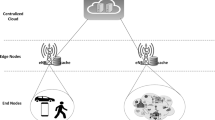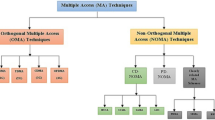Abstract
In this paper, we introduce an effective bandwidth-based call admission control (CAC) with adaptive modulation technique to manage the traffic in a wireless IP-based network. Furthermore, in order to efficiently use the physical resources of the network, we take advantage of an adaptive MQAM (M-ary quadrature amplitude modulation) to match transmission rates to the time-varying channel conditions. This cross-layer architecture has been examined for the self-similar traffic model. The results show that by simultaneous implementation of the effective bandwidth algorithm in the data-link layer and adaptive modulation technique in the physical layer, the performance of the wireless network in terms of the number of rejected calls and system throughput improves.
Similar content being viewed by others
References
Aboutrab, N., & Mohammadi, A. (2008). Design and analysis of wireless systems using CAC and M-QAM adaptive modulation for throughput improvement. In Proceedings of 4th IEEE international conference on circuits and systems for communications (ICCSC 2008) (pp. 255–259).
Alouini, M. S., & Goldsmith, A. J. (2000). Adaptive modulation over Nakagami fading channels. IEEE Journal on Selected Areas on Communications, 13(1–2), 119–143.
Beran, J., Sherman, R., Taqqu, M. S., & Willinger, W. (1995). Long-range dependence in variable bit rate video traffic. IEEE Transaction on Communications, 43(2/3/4).
Chung, S. T., & Goldsmith, A. J. (2001). Degrees of freedom in adaptive modulation: a unified view. IEEE Transaction on Communications, 49(5), 1561–1571.
Ericsson, N. C. (1999). Adaptive modulation and scheduling of IP traffic over fading channels. In IEEE VTC’99 (pp. 849–853).
Evans, J. S., & Everitt, D. (1999). Effective bandwidth-based admission control for multiservice CDMA cellular networks. IEEE Transaction on Vehicular Technology, 48(1).
Garret, M. W., & Willinger, W. (1994). Analysis, modeling and generation of self-similar VBR video traffic. In Proc. ACM sigcomm’94, London (pp. 269–280).
IEEE Standard 802.16 Working Group (2002). IEEE standard for local and metropolitan area networks part 16: Air interface for fixed broadband wireless access systems.
Jafari, A., & Mohammadi, A. (2009). Telecommunication systems : Vol. 42. A cross layer approach based on queuing and adaptive modulation for MIMO systems. Berlin: Springer.
Karaoguz, J. (2001). High-rate wireless personal area networks. IEEE Communication Magazine, 39(12), 96–102.
Leland, W. E., Taqqu, M. S., Willinger, W., & Wilson, D. V. (1994). On the self-similar nature of ethernet traffic. IEEE/ACM Transactions on Networking, 2(1), 1–15.
Liu, Q., Zhou, Sh., & Giannakis, G. B. (2004). Cross-layer combining of adaptive modulation and coding with truncated ARQ over wireless link. IEEE Transaction on Wireless Communications, 3(5), 1746–1754.
Liu, Q., Zhou, Sh., & Giannakis, G. B. (2005). Queuing with adaptive modulation and coding over wireless links: cross-layer analysis and design. IEEE Transaction on Wireless Communications, 4(3), 1142–1152.
Mohammadi, A., & Kumar, S. (2004). Characterization of adaptive modulators in fixed wireless ATM networks. Journal of Communications and Networks, 6(2), 123–132.
Mohammadi, A., Kumar, S., & Klymyshyn, D. (1997). Characterization of effective bandwidth as a metric of quality of service for WIRED and wireless ATM networks. In IEEE international conference on communications, ICC’97 (pp. 1019–1024).
Noh, K., Hong, S. W., Hwang, Y. H., & Yae, B. H. (2006). New call admission control mechanisms considering adaptive modulation control. In ICACT2006 (pp. 413–418).
Wu, D., & Negi, R. (2003). Effective capacity: a wireless link model for support of quality of service. IEEE Transaction on Wireless Communications, 2(4), 630–643.
Zhang, X., & Tang, J. (2006). Cross-layer-based modeling for quality of service guarantees in mobile wireless networks. IEEE Communications Magazine, 100–106.
Author information
Authors and Affiliations
Corresponding author
Rights and permissions
About this article
Cite this article
Aboutorab, N., Mohammadi, A. A cross-layer design of wireless IP systems using effective bandwidth and MQAM adaptive modulation. Telecommun Syst 46, 343–351 (2011). https://doi.org/10.1007/s11235-010-9292-4
Published:
Issue Date:
DOI: https://doi.org/10.1007/s11235-010-9292-4




